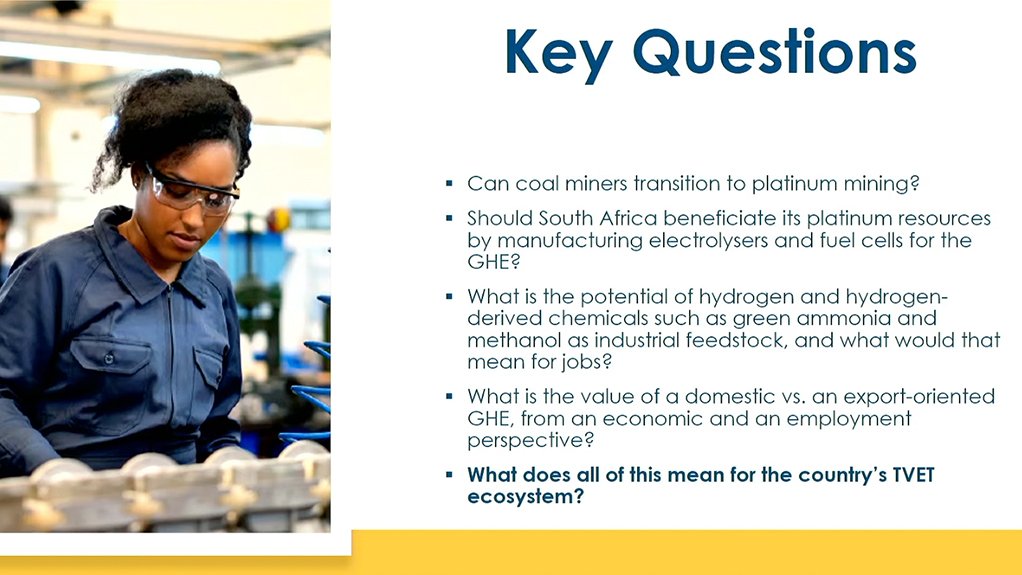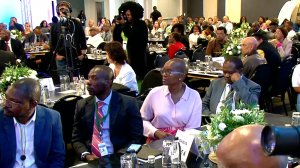Green hydrogen can be near-future reality with collaboration, says Science Minister






Higher Education, Science and Innovation Minister Blade Nzimande.
European Commission Joint Research Centre director-general Stephen Quest.
Photo by Creamer Media
UK High Commissioner Antony Phillipson.
Attendees of the green hydrogen event.
Key energy transition questions.
JOHANNESBURG (miningweekly.com) – The transition to green hydrogen can be a hugely beneficial reality in the near future with collaboration between companies, countries and knowledge institutions, Higher Education, Science and Innovation Minister Blade Nzimande told a just transition event attended by European Commission Joint Research Centre director-general Stephen Quest, UK High Commissioner Antony Phillipson and representatives of neighbouring African States.
The Minister also emphasised the vital role provincial and municipal governments need to play in collaboration with countries such as Namibia and Angola, as well as partners such as the European Union, the UK, Netherlands, and Japan.
“If we indeed work together, we can speed up the energy transition and make the green hydrogen economy a reality in the near future,” said Nzimande, whose Ministry has been at the forefront of exploring ways in which South Africa can play a significant role in the green hydrogen economy.
Public Works and Infrastructure Minister Patricia de Lille has afforded special integrated project, or SIP, status to the R100-billion Hive Hydrogen project in Coega, Nelson Mandela Bay, led by former Standard Bank chairperson and one-time Eskom CEO Thulani Gcabashe, the current Hive Hydrogen South Africa executive chairperson.
The burgeoning outlook for the platinum-based green hydrogen economy is highlighting the need for green artisan and green technician development.
Recommended is that South Africa equips its technical and vocational education and training (TVET) colleges to develop pathways from high-carbon to zero-carbon jobs through the formal Green Hydrogen TVET Ecosystem Just Transition Strategic Framework aimed at helping South Africa’s workforce to prepare for an emerging green hydrogen economy, in which the Public Investment Corporation (PIC) calculates that investment of more than R4.3-trillion is required.
The hydrogen investment strategy of the PIC, which has R2.339-trillion worth of assets under management, is aimed at unlocking value through providing early-stage capital for the development of the hydrogen value chain and leveraging off more than 200 hydrogen projects that have been announced worldwide.
The PIC sees hydrogen as the next frontier in clean energy technology owing to its extensive value chain applications.
In addition, H2Global – a market ramp-up instrument that serves as an innovative form of subsidy scheme to smooth out bumps along green hydrogen’s early-mover road – has made a strong call for final investment decisions to be taken on the multiplicity of green hydrogen projects that are already underpinned by memoranda of understanding.
TVET colleges are being enhanced to play a more pivotal role than ever before in the rapid expansion of renewable energy generation and the transition away from fossil-fuel dependence.
“In transitioning to the inclusive green hydrogen economy, the TVET ecosystem needs to cultivate transversal skills, develop a knowledge commons for skills and create an enabling, collaborative environment to address local shifts and challenges,” Nzimande told the event as green hydrogen emerges as an area of huge investment potential in South Africa and Africa.
“We’re a continent of wind and the sun and like Africa is the cradle of humankind, it is also a future primary source of alternative energy, such as green hydrogen,” said Nzimande, who added that the focus would be on green hydrogen exports, local electrolyser and fuel cell production, and the manufacture of green steel, sustainable aviation fuel, ammonia fertilisers and renewable energy components.
South Africa had to potential, the Minister said, to generate between six-million tonnes and 13-million tonnes of green hydrogen and green hydrogen derivatives by 2050, an output which would require from 140 GW to 300 GW of renewable energy, and the just energy transition requiring even closer collaboration between industrial companies, innovative small and medium-sized enterprises, training facilities, financial institutes, investment partners and governments.
On the skills development front, TVET colleges are seen as not only having the potential to empower young people, but also enabling workers to transition from fossil fuels into the green labour market.
“In short, we need green artisans. That’s the challenge, and around which we can also cooperate across the world,” Nzimande told the hybrid event covered by Mining Weekly.
To build on last week’s South African Green Hydrogen Summit, a series of workshops have been announced on science diplomacy for economic development through green hydrogen.
Nzimande expressed the hope for strong international collaboration, with three more workshops being scheduled in South Africa, along with workshops in the Netherlands, Japan and Belgium.
In 2007, the publication of the Hydrogen and Fuel Technologies Research Development and Innovation Strategy led to the Cabinet adopting the national Hydrogen South Africa flagship programme, better known as HySA.
In October 2021, a commission identified Mogalakwena in Limpopo, Johannesburg in Gauteng, and Durban and Richards Bay in KwaZulu-Natal as green hydrogen hubs within a hydrogen transport corridor backed by digital and Fourth Industrial Revolution technologies.
Article Enquiry
Email Article
Save Article
Feedback
To advertise email advertising@creamermedia.co.za or click here
Press Office
Announcements
What's On
Subscribe to improve your user experience...
Option 1 (equivalent of R125 a month):
Receive a weekly copy of Creamer Media's Engineering News & Mining Weekly magazine
(print copy for those in South Africa and e-magazine for those outside of South Africa)
Receive daily email newsletters
Access to full search results
Access archive of magazine back copies
Access to Projects in Progress
Access to ONE Research Report of your choice in PDF format
Option 2 (equivalent of R375 a month):
All benefits from Option 1
PLUS
Access to Creamer Media's Research Channel Africa for ALL Research Reports, in PDF format, on various industrial and mining sectors
including Electricity; Water; Energy Transition; Hydrogen; Roads, Rail and Ports; Coal; Gold; Platinum; Battery Metals; etc.
Already a subscriber?
Forgotten your password?
Receive weekly copy of Creamer Media's Engineering News & Mining Weekly magazine (print copy for those in South Africa and e-magazine for those outside of South Africa)
➕
Recieve daily email newsletters
➕
Access to full search results
➕
Access archive of magazine back copies
➕
Access to Projects in Progress
➕
Access to ONE Research Report of your choice in PDF format
RESEARCH CHANNEL AFRICA
R4500 (equivalent of R375 a month)
SUBSCRIBEAll benefits from Option 1
➕
Access to Creamer Media's Research Channel Africa for ALL Research Reports on various industrial and mining sectors, in PDF format, including on:
Electricity
➕
Water
➕
Energy Transition
➕
Hydrogen
➕
Roads, Rail and Ports
➕
Coal
➕
Gold
➕
Platinum
➕
Battery Metals
➕
etc.
Receive all benefits from Option 1 or Option 2 delivered to numerous people at your company
➕
Multiple User names and Passwords for simultaneous log-ins
➕
Intranet integration access to all in your organisation



















